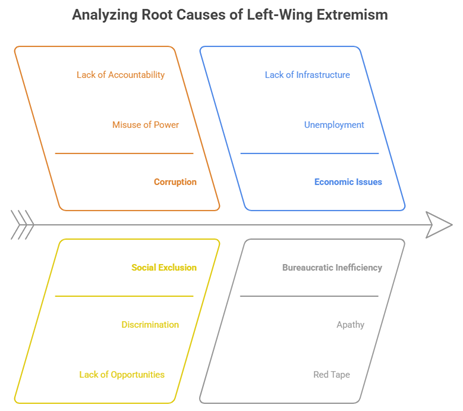The Government of India recently stated that “The end of Left-Wing Extremism has begun.” In this context, examine the broader strategy behind India’s special campaign to eliminate Naxalism by 2026.
Answer: India’s assertion that "the end of Left-Wing Extremism (LWE) has begun" marks a paradigm shift — a fusion of kinetic operations with inclusive development — through a special campaign aimed at dismantling Maoist strongholds and achieving complete elimination by 2026.

Two-Pronged Strategy to Combat LWE
Security Measures
- Modernization of Security Forces: The government has upgraded CRPF and CoBRA units, equipping them with advanced technology and weapons for operations in difficult terrains. Example: Use of drones, satellite imagery, and night-vision tech enhances tactical advantages in ....
Do You Want to Read More?
Subscribe Now
Take Annual Subscription and get the following Advantage
The annual members of the Civil Services Chronicle can read the monthly content of the magazine as well as the Chronicle magazine archives.
Readers can study all the material before the last six months of the Civil Services Chronicle monthly issue in the form of Chronicle magazine archives.
Related Content
- 1 Political apathy among citizens weakens democratic institutions and accountability. Discuss the ethical dimensions of political apathy and suggest measures to promote responsible civic participation.
- 2 A constructive attitude is crucial for public servants dealing with complex challenges and high-pressure situations. What factors contribute to developing such an attitude in individuals?
- 3 “The consequences of moral actions may not be immediate, but they are enduring.” Explain this statement with examples.
- 4 “Punishing corruption without addressing the mindset behind it is a short-term fix.” How can a shift in attitudes among public servants and citizens contribute to long-term anti-corruption efforts?
- 5 Reports of deepfake videos and AI-generated misinformation are steadily rising in India, often resulting in reputational harm and mental distress. In light of such developments, what are the ethical dimensions of human behaviour in the digital world? How can families and educational institutions contribute to fostering digital responsibility and empathy among youth?
- 6 How can the AgriStack initiative contribute to increasing agricultural productivity and income in India? What concerns have emerged regarding its implementation?
- 7 “India’s air defence system stands as a multi-layered, technologically sophisticated framework that shields the nation from diverse aerial threats.” Explain.
- 8 "Emerging technologies offer transformative capabilities in border management, but also pose operational challenges." Analyze this statement in the context of India’s efforts to modernize its border infrastructure and surveillance capabilities.
- 9 What is Flexible Inflation Targeting (FIT)? In the context of India’s emerging macroeconomic scenario, evaluate its effectiveness in achieving its stated objectives.
- 10 Highlight the constitutional and legal provisions governing the Delimitation Commission in India and discuss why the upcoming delimitation exercise has raised concerns in southern states.
UPSC
- 1 Political apathy among citizens weakens democratic institutions and accountability. Discuss the ethical dimensions of political apathy and suggest measures to promote responsible civic participation.
- 2 A constructive attitude is crucial for public servants dealing with complex challenges and high-pressure situations. What factors contribute to developing such an attitude in individuals?
- 3 “The consequences of moral actions may not be immediate, but they are enduring.” Explain this statement with examples.
- 4 “Punishing corruption without addressing the mindset behind it is a short-term fix.” How can a shift in attitudes among public servants and citizens contribute to long-term anti-corruption efforts?
- 5 Reports of deepfake videos and AI-generated misinformation are steadily rising in India, often resulting in reputational harm and mental distress. In light of such developments, what are the ethical dimensions of human behaviour in the digital world? How can families and educational institutions contribute to fostering digital responsibility and empathy among youth?
- 6 How can the AgriStack initiative contribute to increasing agricultural productivity and income in India? What concerns have emerged regarding its implementation?
- 7 “India’s air defence system stands as a multi-layered, technologically sophisticated framework that shields the nation from diverse aerial threats.” Explain.
- 8 "Emerging technologies offer transformative capabilities in border management, but also pose operational challenges." Analyze this statement in the context of India’s efforts to modernize its border infrastructure and surveillance capabilities.
- 9 What is Flexible Inflation Targeting (FIT)? In the context of India’s emerging macroeconomic scenario, evaluate its effectiveness in achieving its stated objectives.
- 10 Highlight the constitutional and legal provisions governing the Delimitation Commission in India and discuss why the upcoming delimitation exercise has raised concerns in southern states.
- 11 In India’s parliamentary structure, the Rajya Sabha is often considered a secondary chamber. Critically examine.
- 12 In the Indian parliamentary system, Department-Related Standing Committees (DRSCs) are often called 'mini-parliaments.' Examine.
- 13 The Small Island Developing States (SIDS) of the Indian Ocean are not only vulnerable regions but also strategic partners in India’s Indo-Pacific vision. Discuss.
- 14 Digital access has become the 'new gateway' to participatory democracy in India. In this context, how does the 2025 Supreme Court judgment declaring digital access as a fundamental right strengthen participatory democracy? Explain with suitable examples.
- 15 Mental health challenges among youth in India are not just personal struggles but indicators of systemic developmental gaps. Examine.
- 16 The concept of "Sponge Cities" is gaining attention in urban areas. Discuss this in the context of ecological stress caused by unplanned urbanisation in India.
- 17 In India, fertility rate has fallen below replacement level. Analyse the implications of this in the context of India’s demographic transition.
- 18 While regionalism in India has often served as a medium for cultural assertion and developmental demands, it can also pose challenges to national integration. Analyse.
- 19 Discuss the mythological significance of the Chakra symbol in Indian traditions.

